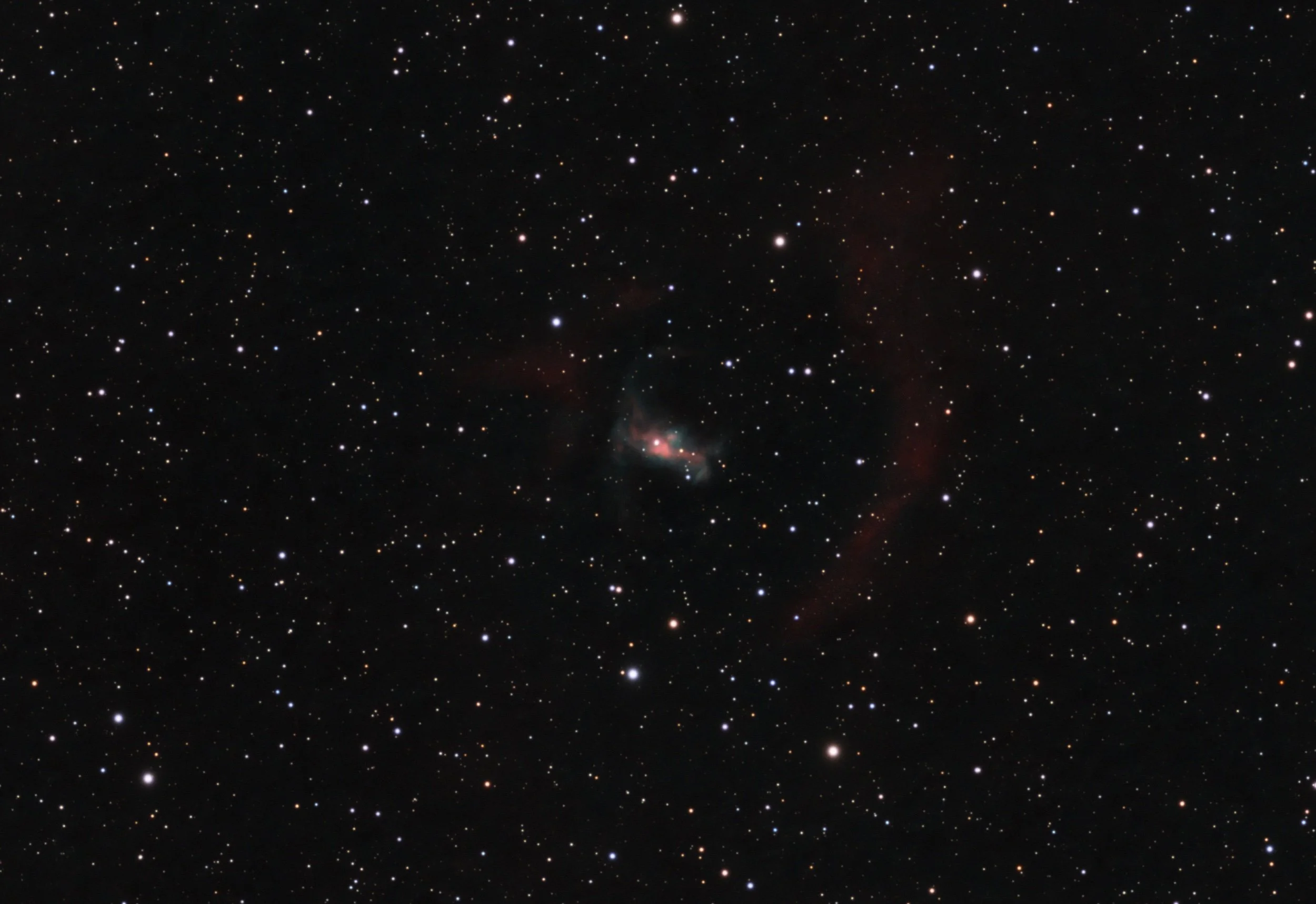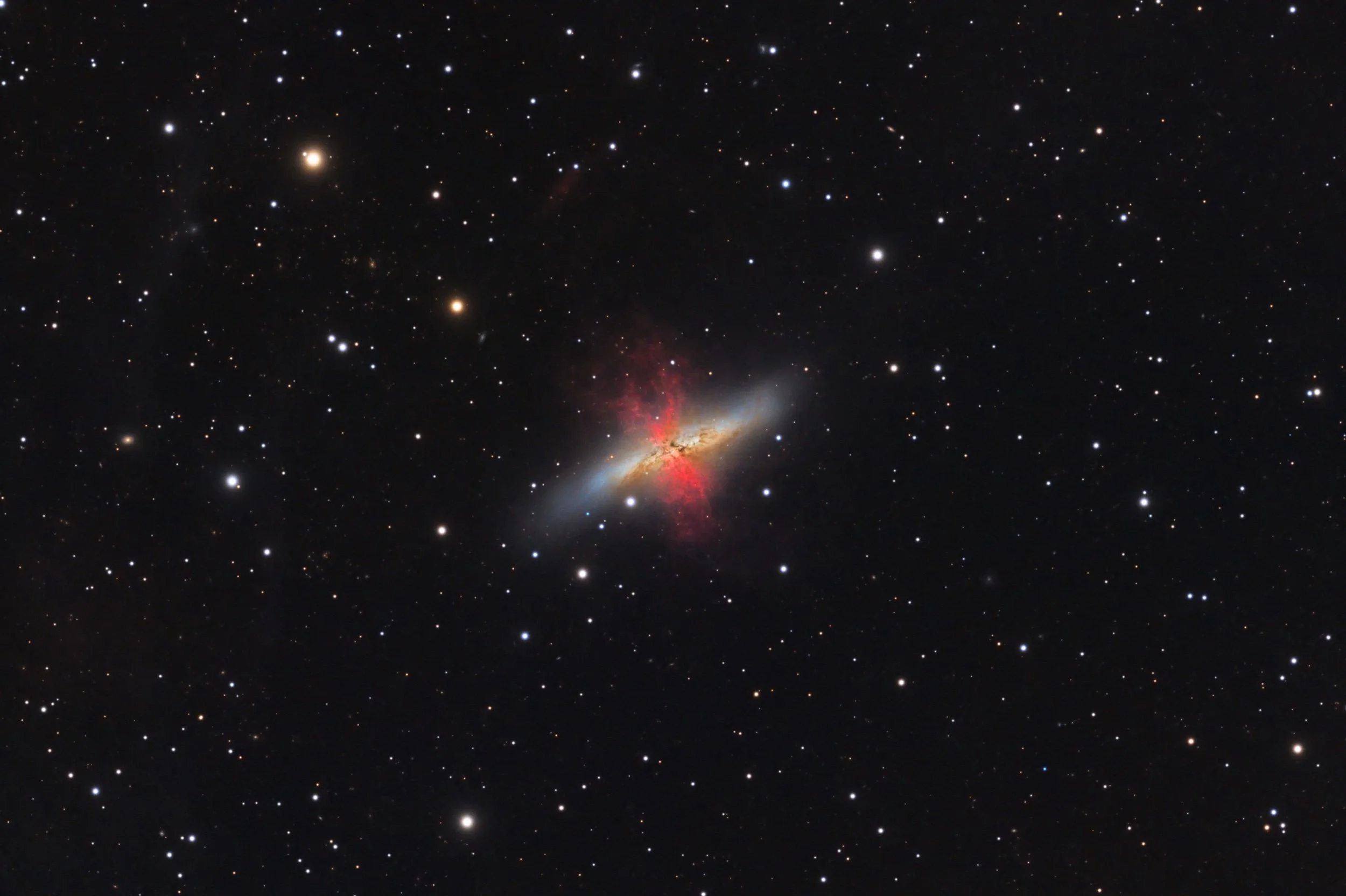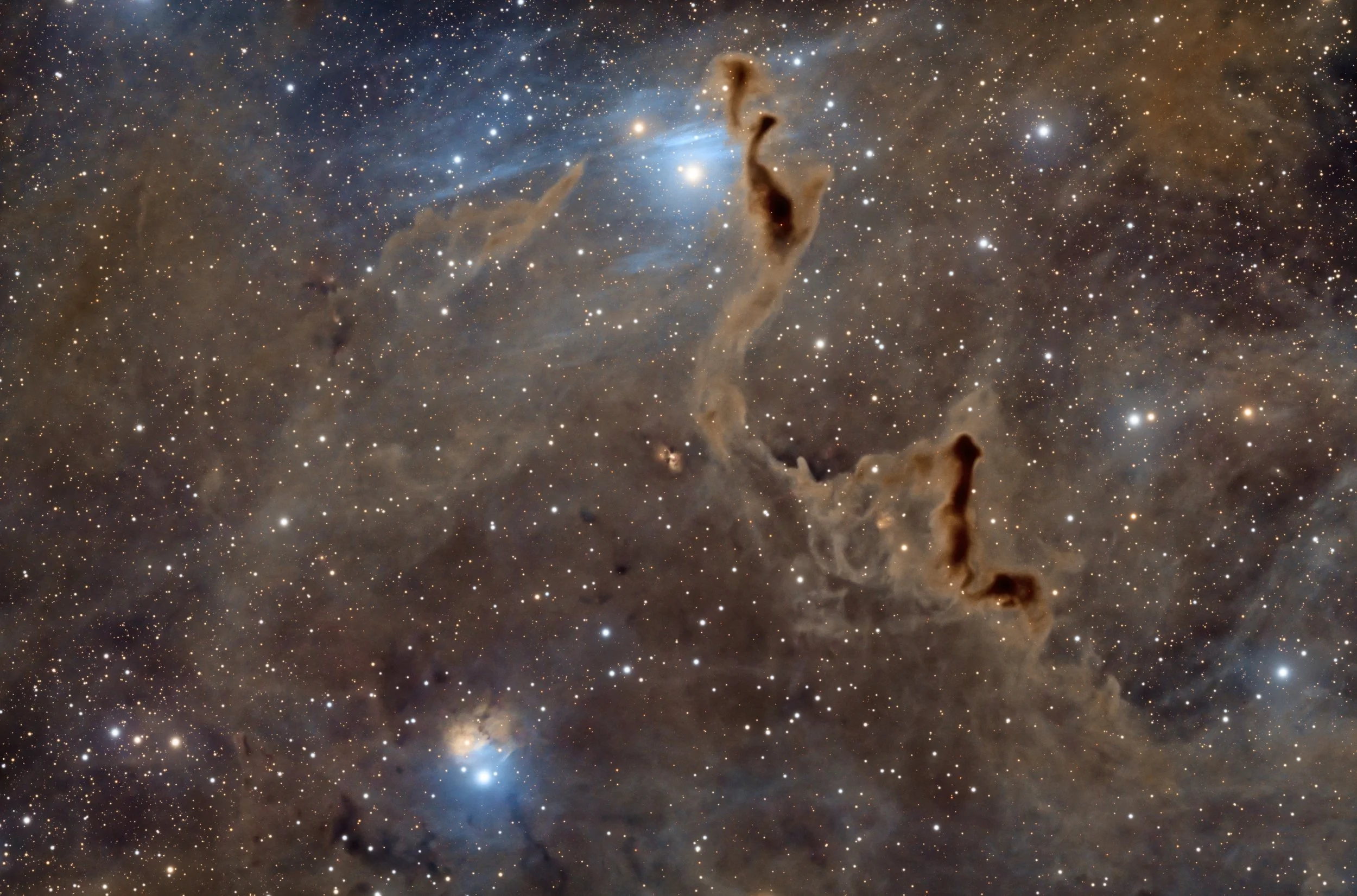
AAPOD2 Image Archives
Kronberger 131 - A mysterious planetary nebula in Auriga
Image Description and Details : Here is a planetary nebula you probably never heard of. Kronberger 131 (Kn131), also known as PN G162.9-01.6 is a mysterious and unusually shaped planetary nebula in the constellation Auriga. Kn 131 is a small and very faint bipolar planetary nebula about 4x3 arc min in size. It has faint wing like appendages on each end and contains HII and OIII emission. Exposed in RGB one would not know something is even here. To the east and west of the nebula is a really faint area of HII emission. Kn131 is also cataloged as PN G162.9-01.6. Looking around the web one can not find any images of this object. This may be the first amateur image. The image is a full resolution crop of the area around the nebula. The image is a HOO image with RGB stars. The image resolution is .62 arcsec/pixel.
Copyright: Jonathan Talbot
M82
The beautiful starburst galaxy M82 is located in the constellation Ursa Major. It was discovered in 1774 by German Astronomer Johann Elert Bode. Bode also discovered nearby M81, also known as Bodes Galaxy.
M82 is undergoing a huge amount of star formation in its core and due to this massive star formation, emits large amounts of hydrogen gas, seen here in red HII light. A possible theory is that gravitational interactions are occurring with the close neighboring galaxy, M81, and are causing this massive star formation to occur.
Also within the image is a bow shock like feature, called the CAP, which is above M82 and near the top of the image. It's a faint red area of HII emission. This feature was discovered in the late 90's and published in 1999. You can find the paper here. A great discussion about this massive amount of material streaming from M82 can be found here: ap130704.html. There are also a bunch of faint background galaxy clusters in the background and if you look at the high res image you can see them in the background.
M82 is approximately 12 million light years distant and about 1/2 the size of our Milky Way galaxy. M82 shines at an apparent magnitude of 8.4.
The image is a LRGB and Ha composite. I started imaging M82 in April of 2021 and finished in January of 2022. It was shot at 1x1 binning at an image scale of .64 arcsec/pixel. To get a high resolution view of M82, click on the image above.
Image Details
Optics : Stellarvue SVX 152T refractor @f8 1200mm FL
Mount: Paramount MYT
Camera: ZWO ASI6200
Filters: Chroma 50mm LRGB, Astrodon 50mm 5nm Ha
Exposure (min): LRGBHa 366:185:200:200:1120 34.5 hrs, 1x1 binning 1/2 frame
Automation Control: The Sky X, Voyager, PrimaluceLab Eagle 4
Guiding: StarlightXpress Lodestar X2
Processing Software: PixInsight, PS CC, Topaz Labs
Location: Stark Bayou Observatory, Ocean Springs, MS
Sky: Typical SQM 19.6-20.1, Bortle 5, Suburban
Date: 25April - 26 May 2021, 14 Nov - 13 Jan 2022
A Helping Hand in Cassiopeia
Image Description and Details :
This image shows a marvelous and busy area in the constellation Cassiopeia. It contains a large amount of dust, several dark nebula and several reflection nebula along with two interesting stars. Near the top center is the star SU Cassiopeiae which is a Cepheid variable at Mag 5.94. SU Cass is a Yellow giant with a spectral class of F5:lb-11. It's 19 times larger than our sun. SU Cass lies 1289 light years distant. Surrounding it is the blue reflection nebula VdB 9 which is lit up by SU Cass. The blue wisps extend quite a ways around this area. The other interesting star in the lower center left is the star RZ Cassiopeiae. RZ Cass is a white A3V main sequence star at mag 6.26. It's an eclipsing variable star which is 219 light years distant. The bluish nebulosity surrounding it is listed as VdB 7. However RZ Cass is apparently not the source to light up VdB 7 but another smaller 11th mag star nearby. Several dark nebula are right of center in the image. The upper part of this nebula looks like an opened hand, hence the nickname (The helping hand). The dark area of the hand, near the top finger is designated as LDN 1357 and below it near the palm, LDN 1355. The long dark area near center right is the dark nebula LDN 1358. Throughout this entire area encompassing the field of view is lots of molecular dust of varying thickness and color. This image was taken under the dark skies of the Okie Tex Star Party in October 2021. It encompasses 14.3 hrs of exposure time using LRGB filters.Scope: Stellarvue SVX 152T, Camera: ZWO ASI 6200mm Pro, Mount: Paramount MyTExposures: Luminance 59@300sec, Red 39@300sec, Green 38@300sec, Blue 36@300secProcessing: PixInsight
Copyright: Jonathan Talbot
NEW DISCOVERY: StDr 140 - Lori's Nebula in Gemini
Image Description and Details :
A new discovery of a candidate planetary nebula in the constellation Gemini. The object was discovered by my good friends the German-French team of Marcel Drechsler and Xavier Strottner in October 2021 using digital sky surveys. This is their 140th joint discovery. Currently, only very few planetary nebulae are known in the Gemini constellation, and now this impressive new nebula has been added. Because the PN candidate is rich in ionised oxygen (OIII), the object appears in a ghostly turquoise blue. It is at an estimated 4,250 light years from Earth.
My thanks to Marcel Drechsler for so expertly processing this image.
Image captured on my remote dual rig at Fregenal de la Sierra in Spain between 4-15 November 2021.
Scopes: APM TMB LZOS 152 Refractors
Cameras: QSI6120wsg8
Mount: 10Micron GM2000 HPS
A total of 76 hours 35 minutes image capture (HaOIIILRGB)
Copyright: Peter Goodhew
Out on a Wing Part 2
Image Description and Details :
Image of the area from Cederblad 90 to beyond NGC 2327 in Monoceros and Canis Major. This area is the right wing of the famous SeaGull Nebula (IC2177) lying approx 3,700 light years distant. The area is full of emission and reflection nebula. 10.2hrs of exposure time with a 152mm refractor and ASI 6200 CMOS camera using LRGB and Ha filters.
Copyright: Jon Talbot
Reflection Nebula NGC 1999
Reflection nebula NGC 1999 in Orion. The small bluish patch of nebulosity with an inverted T at its center is enveloped within a much larger area of emission nebulosity in Orion. The nebula is illuminated by the variable star V380 Orionis which is visible right nest to the dark inverted T. This dark are is a source of much discussion and has been images by many of the great observatories.
The Great Spiral in Triangulum- M33
Image Description and Details : The great spiral galaxy M33 in Triangulum, a favorite among imagers, imaged from my home observatory under suburban Bortle 5 skies, during the month of Oct, early Nov 2019. Stellarvue SVX152T @f8, 1200mm FL on a Paramount MyT. QSI 683 camera using Luminance, Red, Green, Blue, and 5nm Ha filters. 360min Luminance bin 1x1, 300min Red, 290min Green, 280min Blue and 660min Ha bin 2x2. Total of 31.5hrs of exposure time. PixInsight used for processing. Please visit the full size link on the web page above to see individual stars resolved within the galaxy.
Copyright: Jon Talbot







